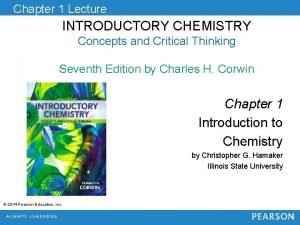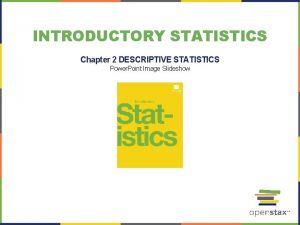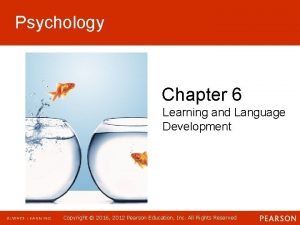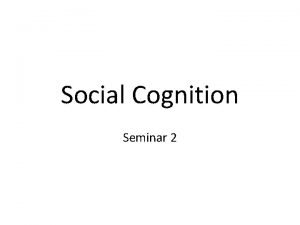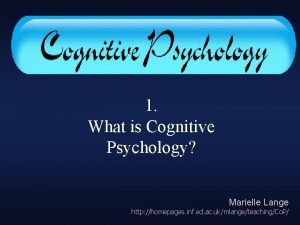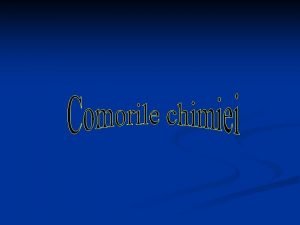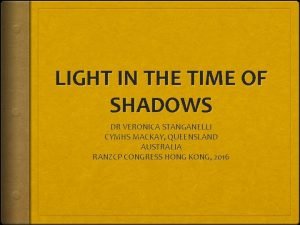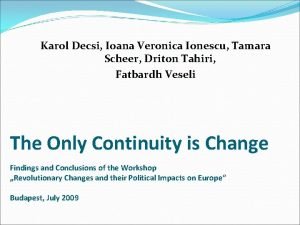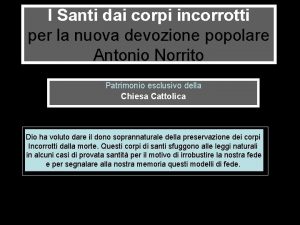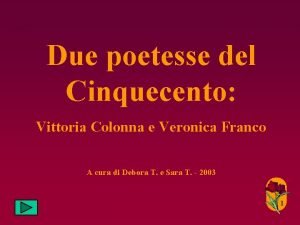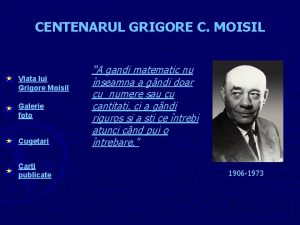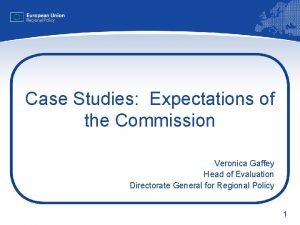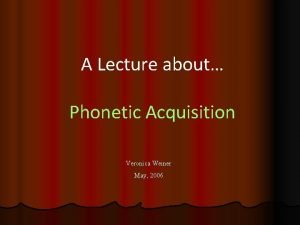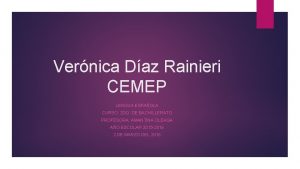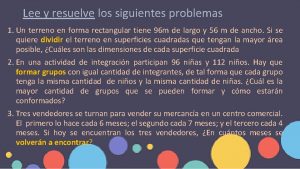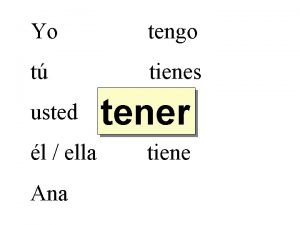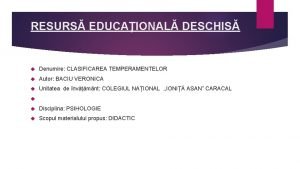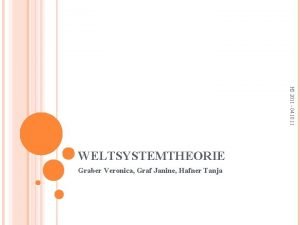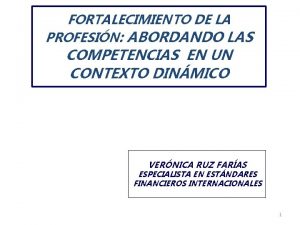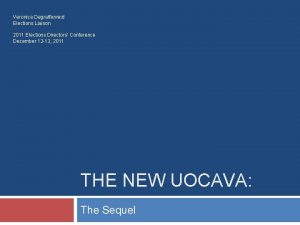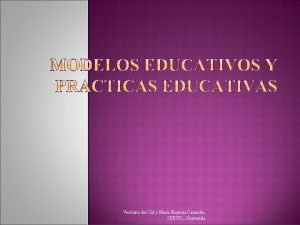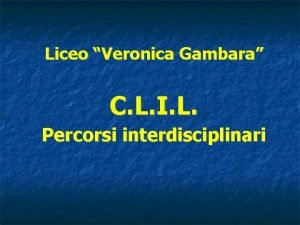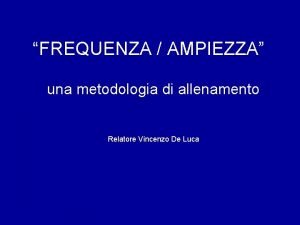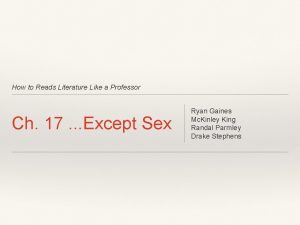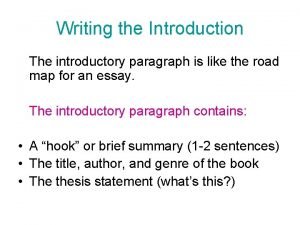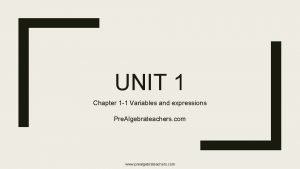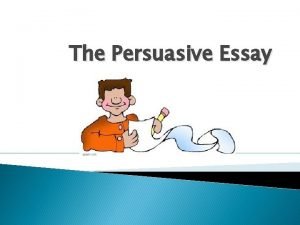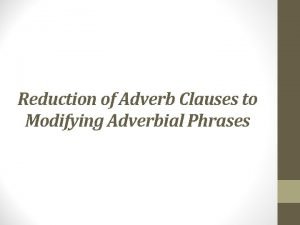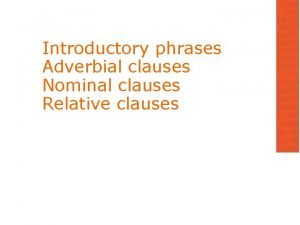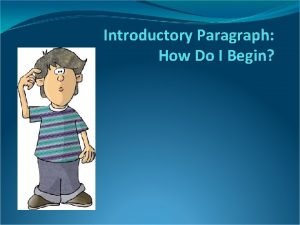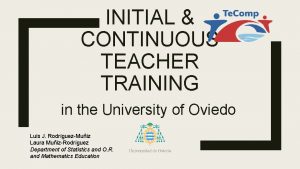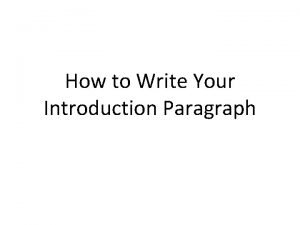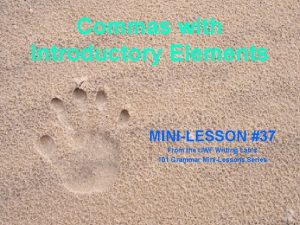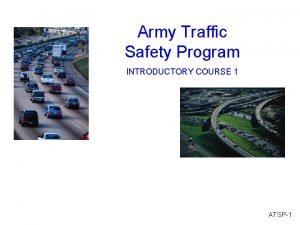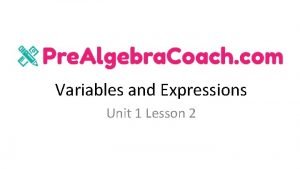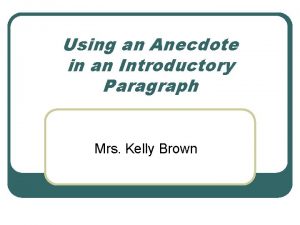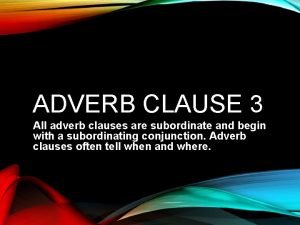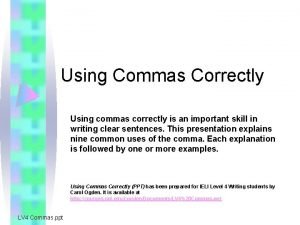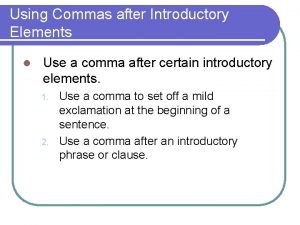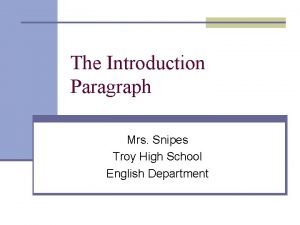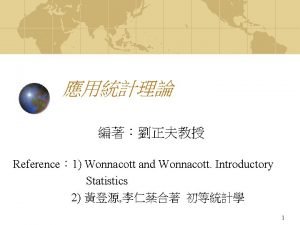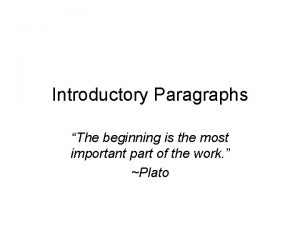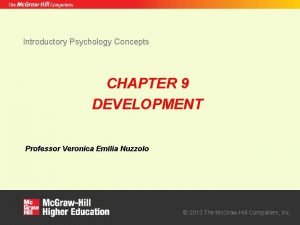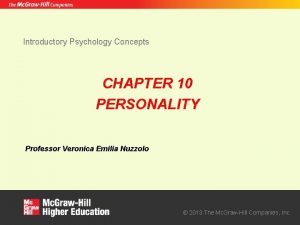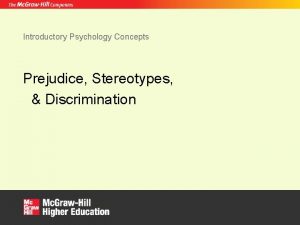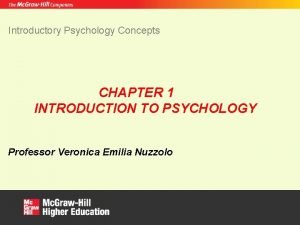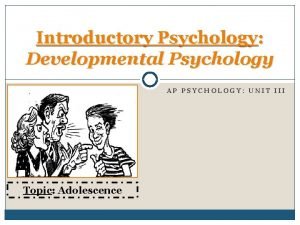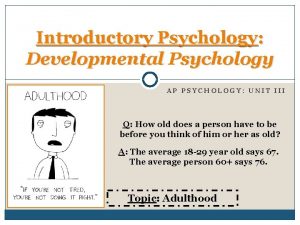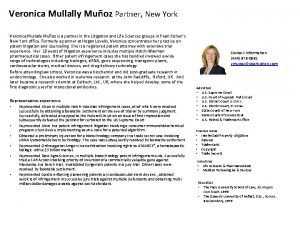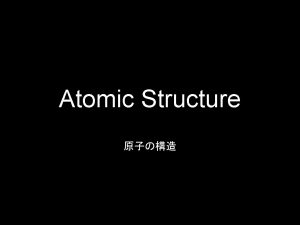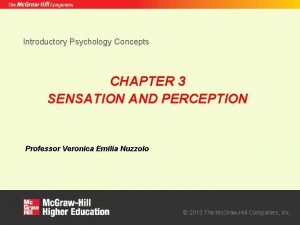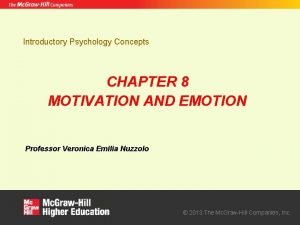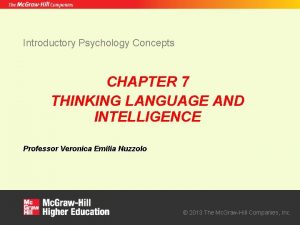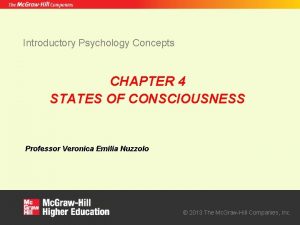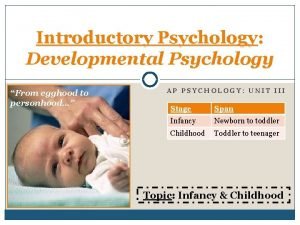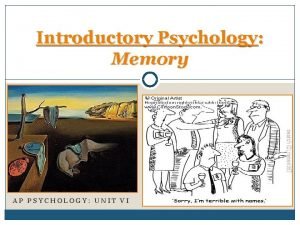Introductory Psychology Concepts CHAPTER 5 LEARNING Professor Veronica





























































































- Slides: 93

Introductory Psychology Concepts CHAPTER 5 LEARNING Professor Veronica Emiia Nuzzolo © 2013 The Mc. Graw-Hill Companies, Inc.

Introductory Psychology Concepts : Learning: A Relatively Permanent Change In Behavior Caused By Experience Or Practice. A man who carries a cat by the tail learns something that he can learn in no other way. —Mark Twain © 2013 The Mc. Graw-Hill Companies, Inc. 5 -2

Introductory Psychology Concepts : Learning Classical Conditioning: The Association Of Two Stimuli In The Environment. Does the mere sight of the golden arches in front of Mc. Donald’s make you feel pangs of hunger and think about hamburgers? If it does, you are displaying an elementary form of learning called classical conditioning. © 2013 The Mc. Graw-Hill Companies, Inc. 5 -3

Introductory Psychology Concepts : Learning Ivan Pavlov + Russian physiologist, never intended to do psychological research. + Won the Nobel Prize for his work on digestion (1904). + Remembered for his experiments on basic learning process, not for his experiments on physiology. Ivan Pavlov (center) developed the principles of classical conditioning. © 2013 The Mc. Graw-Hill Companies, Inc. 5 -4

Introductory Psychology Concepts : Learning Pavlov’s Classic Experiment: Salivating Dogs (1927) Before conditioning, the ringing of a bell does not bring about salivation— making the bell a neutral stimulus. © 2013 The Mc. Graw-Hill Companies, Inc. 5 -5

Introductory Psychology Concepts : Learning Pavlov’s Classic Experiment: Salivating Dogs (1927) In contrast, meat naturally brings about salivation, making the meat an unconditioned stimulus and salivation an unconditioned response. © 2013 The Mc. Graw-Hill Companies, Inc. 5 -6

Introductory Psychology Concepts : Learning Pavlov’s Classic Experiment: Salivating Dogs (1927) During conditioning, the bell is rung just before the presentation of the meat. © 2013 The Mc. Graw-Hill Companies, Inc. 5 -7

Introductory Psychology Concepts : Learning Pavlov’s Classic Experiment: Salivating Dogs (1927) Eventually, the ringing of the bell alone brings about salivation. © 2013 The Mc. Graw-Hill Companies, Inc. 5 -8

Introductory Psychology Concepts : Learning Classical Conditioning Paradigm UCS: Unconditioned Stimulus A stimulus that naturally brings about a particular response without having been learned. © 2013 The Mc. Graw-Hill Companies, Inc. 5 -9

Introductory Psychology Concepts : Learning Classical Conditioning Paradigm UCS: Unconditioned Stimulus A stimulus that naturally brings about a particular response without having been learned. UCR: Unconditioned Response A response that is natural and needs no training. © 2013 The Mc. Graw-Hill Companies, Inc. 5 -10

Introductory Psychology Concepts : Learning Classical Conditioning Paradigm UCS: Unconditioned Stimulus A stimulus that naturally brings about a particular response without having been learned. UCR: Unconditioned Response A response that is natural and needs no training. CS: Conditioned Stimulus A once-neutral stimulus that has been paired with an unconditioned stimulus to bring about a response formerly caused only by the unconditioned stimulus © 2013 The Mc. Graw-Hill Companies, Inc. 5 -11

Introductory Psychology Concepts : Learning Classical Conditioning Paradigm UCS: Unconditioned Stimulus A stimulus that naturally brings about a particular response without having been learned. UCR: Unconditioned Response A response that is natural and needs no training. CS: Conditioned Stimulus A once-neutral stimulus that has been paired with an unconditioned stimulus to bring about a response formerly caused only by the unconditioned stimulus CR: Conditioned Response A response that, after conditioning, follows a previously neutral stimulus. © 2013 The Mc. Graw-Hill Companies, Inc. 5 -12

Introductory Psychology Concepts : Learning Operant Conditioning: Behavior Followed By A Consequence The Skinner box is a chamber with a highly controlled environment, used to study operant conditioning processes with laboratory animals. Animals press levers in response to stimuli in order to receive “rewards”. © 2013 The Mc. Graw-Hill Companies, Inc. 5 -13

Introductory Psychology Concepts : Learning Reinforcement and Punishment: Positive and negative types When stimulus is added, the result is. . . Positive Reinforcement Intended Results Increase in behavior (reinforcement) Example: Giving a raise for good performance. Results: INCREASE in response of good performance. © 2013 The Mc. Graw-Hill Companies, Inc. 5 -14

Introductory Psychology Concepts : Learning Reinforcement and Punishment: Positive and negative types When stimulus is added, the result is. . . Positive Punishment Intended Results Decrease in behavior (punishment) Example: Yelling at a teenager for stealing a bracelet. Results: DECREASE in frequency of response of stealing. © 2013 The Mc. Graw-Hill Companies, Inc. 5 -15

Introductory Psychology Concepts : Learning Reinforcement and Punishment: Positive and negative types When stimulus is removed, the result is. . . Negative Reinforcement Intended Results Increase in behavior (reinforcement) Example: Applying ointment to relieve itchy rash leads to higher future likelihood of applying ointment. Results: INCREASE in response of using ointment © 2013 The Mc. Graw-Hill Companies, Inc. 5 -16

Introductory Psychology Concepts : Learning Reinforcement and Punishment: Positive and negative types When stimulus is removed, the result is. . . Negative Punishment Intended Results Decrease in behavior (punishment) Example: Teenager’s access to car restricted by parents due to teenager’s breaking curfew. Results: DECREASE in response of breaking curfew. © 2013 The Mc. Graw-Hill Companies, Inc. 5 -17

Introductory Psychology Concepts : Learning Schedules of Reinforcement: Different Patterns Of Frequency and Timing Of Reinforcement Following Desired Behavior Continuous Reinforcement Schedule: § Reinforcing a behavior every time it occurs. Prior experience has taught us that a candy machine delivers reinforcement (candy) every time we put in the appropriate amount of money. If the candy machine were broken, it would not take very long before we stopped depositing coins. © 2013 The Mc. Graw-Hill Companies, Inc. 5 -18

Introductory Psychology Concepts : Learning Schedules of Reinforcement: Different Patterns Of Frequency and Timing Of Reinforcement Following Desired Behavior Partial (Intermittent) Reinforcement Schedule: § Reinforcing a behavior some but not all of the time. Prior experience with a slot machine has taught us that after putting in our cash, most of the time we will not receive anything in return. At the same time, we know that we will occasionally win something. In comparison with the candy machine—If the slot machine were broken, we would drop in money for a considerably longer time, even though there would be no payoff. © 2013 The Mc. Graw-Hill Companies, Inc. 5 -19

Introductory Psychology Concepts : Learning Cumulative frequency of responses Partial Reinforcement Schedules: Fixed-Ratio Schedule: A schedule by which reinforcement is given only after a specific number of responses are made. Typical Outcome: There are short pauses after each response. Short pauses occur after each response. Because the more responses, the more reinforcement, fixed-ratio schedules produce a high rate of responding. Time © 2013 The Mc. Graw-Hill Companies, Inc. 5 -20

Introductory Psychology Concepts : Learning Cumulative frequency of responses Partial Reinforcement Schedules: Variable-Ratio Schedule: Responding occurs at a high, steady rate. A schedule by which reinforcement occurs after a varying number of responses rather than after a fixed number. Typical Outcome: Responding occurs at a high rate. Time © 2013 The Mc. Graw-Hill Companies, Inc. 5 -21

Introductory Psychology Concepts : Learning Cumulative frequency of responses Partial Reinforcement Schedules: Fixed-Interval Schedule: There are typically long pauses after each response. Reinforcement for a response occurs only if a fixed time period has elapsed, making overall rates of response relatively low. Typical Outcome: Time © 2013 The Mc. Graw-Hill Companies, Inc. Produces lower rates of responding, especially just after reinforcement has been presented. (The organism learns that a specified time period must elapse between reinforcements. ) 5 -22

Introductory Psychology Concepts : Learning Cumulative frequency of responses Partial Reinforcement Schedules: Variable-Interval Schedule: A schedule by which the time between reinforcements varies around some average rather than being fixed. Typical Outcome: Produces a fairly steady stream of responses. Responding occurs at a steady rate. Time © 2013 The Mc. Graw-Hill Companies, Inc. 5 -23

Introductory Psychology Concepts : Learning Laws of Learning Acquisition (conditioned response and unconditioned response presented together) Strength of Conditioned Response (CR) STRONG WEAK Training CS alone Pause Spontaneous recovery TIME © 2013 The Mc. Graw-Hill Companies, Inc. 5 -24

Introductory Psychology Concepts : Learning Laws of Learning Extinction (conditioned stimulus by itself) A basic phenomenon of learning that occurs when a previously conditioned response decreases in frequency and eventually disappears. Acquisition Strength of Conditioned Response (CR) STRONG WEAK Training CS alone Pause Spontaneous recovery TIME © 2013 The Mc. Graw-Hill Companies, Inc. 5 -25

Introductory Psychology Concepts : Learning Laws of Learning Acquisition Extinction Spontaneous Recovery The reemergence of an extinguished conditioned response after a period of rest and with no further conditioning. STRONG Strength of Conditioned Response (CR) Spontaneous recovery of conditioned response WEAK Extinction follows (conditioned stimulus alone) Training CS alone Pause Spontaneous recovery TIME © 2013 The Mc. Graw-Hill Companies, Inc. 5 -26

Introductory Psychology Concepts : Learning Laws of Learning Stimulus Generalization • • Occurs when a conditioned response follows a stimulus that is similar to the original conditioned stimulus The more similar the two stimuli are, the more likely generalization is to occur. Stimulus Discrimination • • The process that occurs if two stimuli are sufficiently distinct from one another that one evokes a conditioned response but the other does not; The ability to differentiate between stimuli. © 2013 The Mc. Graw-Hill Companies, Inc. 5 -27

Introductory Psychology Concepts : Learning Cognitive Learning: Learning That Requires Cognition And Thought Processes Cognitive Learning Theory • • • An approach to the study of learning that focuses on the thought processes that underlie learning. Challenges the stimulus-response (S-R) model, Argues that in between stimulus and response there is the organism’s (O) view of the world (S-O-R). © 2013 The Mc. Graw-Hill Companies, Inc. 5 -28

Introductory Psychology Concepts : Learning Tolman and Latent Learning: Learning That Remains Hidden Until It Becomes Useful Tolman’s Demonstration + Rats were allowed to roam through a maze once a day for seventeen days. Feldman 208 a + One group was reinforced with food every time they reached the end of the maze + One group never received reinforcement. + The experimental group received food reinforcement on day 11. © 2013 The Mc. Graw-Hill Companies, Inc. 5 -29

Introductory Psychology Concepts : Learning Tolman and Latent Learning: Learning That Remains Hidden Until It Becomes Useful Tolman’s Results + Unrewarded control group consistently made the most errors. + Rewarded control group made far fewer errors. + Experimental group showed immediate reduction in errors after they began receiving reward. This suggests that the experimental group had learned the maze prior to the introduction of reinforcement. © 2013 The Mc. Graw-Hill Companies, Inc. 5 -30

Introductory Psychology Concepts : Learning Kohler and Insight: Sudden Perceptions of Relationships Allowing For Rapid Problem Solving In the 1920’s, German psychologist Wolfgang Kohler exposed chimpanzees to novel learning tasks and concluded that they were able to learn by insight. Sultan the chimpanzee seems to study the hanging bananas that are out of reach. © 2013 The Mc. Graw-Hill Companies, Inc. 5 -31

Introductory Psychology Concepts : Learning Kohler and Insight: Sudden Perceptions of Relationships Allowing For Rapid Problem Solving After looking around, Sultan suddenly grabs some crates, and stacks them. . . © 2013 The Mc. Graw-Hill Companies, Inc. 5 -32

Introductory Psychology Concepts : Learning Kohler and Insight: Sudden Perceptions of Relationships Allowing For Rapid Problem Solving Sultan obtains his tasty reward. © 2013 The Mc. Graw-Hill Companies, Inc. 5 -33

Introductory Psychology Concepts : Learning Observational Learning: learning through watching others In Bandura’s (1965) experiment, most children who watched an aggressive model attack a Bobo doll later imitated that behavior. © 2013 The Mc. Graw-Hill Companies, Inc. 5 -34

Classical Conditioning: the association of two stimuli in the environment. Does the mere sight of the golden arches in front of Mc. Donald’s makes you feel pangs of hunger and think about hamburgers? If it does, you are displaying an elementary form of learning called classical conditioning. © 2013 The Mc. Graw-Hill Companies, Inc. 5 -35

Ivan Pavlov + Russian physiologist, never intended to do psychological research. + Won the Nobel Prize for his work on digestion (1904). + Remembered for his experiments on basic learning process, not for his experiments on physiology. Ivan Pavlov (center) developed the principles of classical conditioning. © 2013 The Mc. Graw-Hill Companies, Inc. 5 -36

Pavlov’s Classic Experiment: Salivating Dogs (1927) Before conditioning, the ringing of a bell does not bring about salivation— making the bell a neutral stimulus. © 2013 The Mc. Graw-Hill Companies, Inc. 5 -37

Pavlov’s Classic Experiment: Salivating Dogs (1927) In contrast, meat naturally brings about salivation, making the meat an unconditioned stimulus and salivation an unconditioned response. © 2013 The Mc. Graw-Hill Companies, Inc. 5 -38

Pavlov’s Classic Experiment: Salivating Dogs (1927) During conditioning, the bell is rung just before the presentation of the meat. © 2013 The Mc. Graw-Hill Companies, Inc. 5 -39

Pavlov’s Classic Experiment: Salivating Dogs (1927) Eventually, the ringing of the bell alone brings about salivation. © 2013 The Mc. Graw-Hill Companies, Inc. 5 -40

Classical Conditioning Paradigm UCS: Unconditioned Stimulus A stimulus that naturally brings about a particular response without having been learned. © 2013 The Mc. Graw-Hill Companies, Inc. 5 -41

Classical Conditioning Paradigm UCS: Unconditioned Stimulus A stimulus that naturally brings about a particular response without having been learned. UCR: Unconditioned Response A response that is natural and needs no training. © 2013 The Mc. Graw-Hill Companies, Inc. 5 -42

Classical Conditioning Paradigm UCS: Unconditioned Stimulus A stimulus that naturally brings about a particular response without having been learned. UCR: Unconditioned Response A response that is natural and needs no training. CS: Conditioned Stimulus A once-neutral stimulus that has been paired with an unconditioned stimulus to bring about a response formerly caused only by the unconditioned stimulus © 2013 The Mc. Graw-Hill Companies, Inc. 5 -43

Classical Conditioning Paradigm UCS: Unconditioned Stimulus A stimulus that naturally brings about a particular response without having been learned. UCR: Unconditioned Response A response that is natural and needs no training. CS: Conditioned Stimulus A once-neutral stimulus that has been paired with an unconditioned stimulus to bring about a response formerly caused only by the unconditioned stimulus CR: Conditioned Response A response that, after conditioning, follows a previously neutral stimulus. © 2013 The Mc. Graw-Hill Companies, Inc. 5 -44

Laws of Learning Acquisition (conditioned response and unconditioned response presented together) Strength of Conditioned Response (CR) STRONG WEAK Training CS alone Pause Spontaneous recovery TIME © 2013 The Mc. Graw-Hill Companies, Inc. 5 -45

Laws of Learning Extinction (conditioned stimulus by itself) A basic phenomenon of learning that occurs when a previously conditioned response decreases in frequency and eventually disappears. Acquisition Strength of Conditioned Response (CR) STRONG WEAK Training CS alone Pause Spontaneous recovery TIME © 2013 The Mc. Graw-Hill Companies, Inc. 5 -46

Laws of Learning Acquisition Extinction Spontaneous Recovery The reemergence of an extinguished conditioned response after a period of rest and with no further conditioning. STRONG Strength of Conditioned Response (CR) Spontaneous recovery of conditioned response WEAK Extinction follows (conditioned stimulus alone) Training CS alone Pause Spontaneous recovery TIME © 2013 The Mc. Graw-Hill Companies, Inc. 5 -47

Applied Classical Conditioning Watson and “Little Albert” (1920) John B. Watson and Rosalie Rayner set out to obtain evidence that fear could be conditioned. © 2013 The Mc. Graw-Hill Companies, Inc. 5 -48

Applied Classical Conditioning Conditioned Taste Aversion + If every time you ate peanuts you had an upset stomach several hours later, you would eventually learn to avoid peanuts, despite the time-lapse between the stimulus of peanuts and response of getting ill. + In fact, you might develop a conditioned taste aversion, so that peanuts no longer even tasted good to you. + Taste aversion can also occur with a single incident—you get the flu after eating a burrito and so don’t want to eat them again. © 2013 The Mc. Graw-Hill Companies, Inc. 5 -49

Applied Classical Conditioning Biological Preparedness + Organisms that ingest unpalatable foods are likely to avoid similar foods in the future, making their survival more likely. (Steinmetz, Kim, & Thompson, 2003; Cox et al. , 2004). Because of prior experience with meat that had been laced with mild poison, this coyote does not obey its natural instincts and ignores what would otherwise be a tasty meal. © 2013 The Mc. Graw-Hill Companies, Inc. 5 -50

Operant Conditioning: Behavior followed by a consequence The Skinner box is a chamber with a highly controlled environment, used to study operant conditioning processes with laboratory animals. © 2013 The Mc. Graw-Hill Companies, Inc. 5 -51

Reinforcement and Punishment: Positive and negative types When stimulus is added, the result is. . . Positive Reinforcement Intended Results Increase in behavior (reinforcement) Example: Giving a raise for good performance. Results: INCREASE in response of good performance. © 2013 The Mc. Graw-Hill Companies, Inc. 5 -52

Reinforcement and Punishment: Positive and negative types When stimulus is added, the result is. . . Positive Punishment Intended Results Decrease in behavior (punishment) Example: Yelling at a teenager for stealing a bracelet. Results: DECREASE in frequency of response of stealing. © 2013 The Mc. Graw-Hill Companies, Inc. 5 -53

Reinforcement and Punishment: Positive and negative types When stimulus is removed, the result is. . . Negative Reinforcement Intended Results Increase in behavior (reinforcement) Example: Applying ointment to relieve itchy rash leads to higher future likelihood of applying ointment. Results: INCREASE in response of using ointment © 2013 The Mc. Graw-Hill Companies, Inc. 5 -54

Reinforcement and Punishment: Positive and negative types When stimulus is removed, the result is. . . Negative Punishment Intended Results Decrease in behavior (punishment) Example: Teenager’s access to car restricted by parents due to teenager’s breaking curfew. Results: DECREASE in response of breaking curfew. © 2013 The Mc. Graw-Hill Companies, Inc. 5 -55

Schedules of Reinforcement: Different patterns of frequency and timing of reinforcement following desired behavior. Continuous Reinforcement Schedule: Reinforcing a behavior every time it occurs. Partial (Intermittent) Reinforcement Schedule: Reinforcing a behavior some but not all of the time. © 2013 The Mc. Graw-Hill Companies, Inc. 5 -56

Cumulative frequency of responses Partial Reinforcement Schedules: Fixed-Ratio Schedule: A schedule by which reinforcement is given only after a specific number of responses are made. Typical Outcome: There are short pauses after each response. Short pauses occur after each response. Because the more responses, the more reinforcement, fixed-ratio schedules produce a high rate of responding. Time © 2013 The Mc. Graw-Hill Companies, Inc. 5 -57

Cumulative frequency of responses Partial Reinforcement Schedules: Variable-Ratio Schedule: Responding occurs at a high, steady rate. A schedule by which reinforcement occurs after a varying number of responses rather than after a fixed number. Typical Outcome: Responding occurs at a high rate. Time © 2013 The Mc. Graw-Hill Companies, Inc. 5 -58

Cumulative frequency of responses Partial Reinforcement Schedules: Fixed-Interval Schedule: There are typically long pauses after each response. A schedule that provides reinforcement for a response only if a fixed time period has elapsed, making overall rates of response relatively low. Typical Outcome: Time © 2013 The Mc. Graw-Hill Companies, Inc. Produces lower rates of responding, especially just after reinforcement has been presented. (The organism learns that a specified time period must elapse between reinforcements. ) 5 -59

Cumulative frequency of responses Partial Reinforcement Schedules: Variable-Interval Schedule: A schedule by which the time between reinforcements varies around some average rather than being fixed. Typical Outcome: Produces a fairly steady stream of responses. Responding occurs at a steady rate. Time © 2013 The Mc. Graw-Hill Companies, Inc. 5 -60

Laws of Learning Acquisition (conditioned response and unconditioned response presented together) Strength of Conditioned Response (CR) STRONG WEAK Training CS alone Pause Spontaneous recovery TIME © 2013 The Mc. Graw-Hill Companies, Inc. 5 -61

Laws of Learning Extinction (conditioned stimulus by itself) A basic phenomenon of learning that occurs when a previously conditioned response decreases in frequency and eventually disappears. Acquisition Strength of Conditioned Response (CR) STRONG WEAK Training CS alone Pause Spontaneous recovery TIME © 2013 The Mc. Graw-Hill Companies, Inc. 5 -62

Laws of Learning Acquisition Extinction Spontaneous Recovery The reemergence of an extinguished conditioned response after a period of rest and with no further conditioning. STRONG Strength of Conditioned Response (CR) Spontaneous recovery of conditioned response WEAK Extinction follows (conditioned stimulus alone) Training CS alone Pause Spontaneous recovery TIME © 2013 The Mc. Graw-Hill Companies, Inc. 5 -63

Laws of Learning Stimulus Generalization • • Occurs when a conditioned response follows a stimulus that is similar to the original conditioned stimulus The more similar the two stimuli are, the more likely generalization is to occur. © 2013 The Mc. Graw-Hill Companies, Inc. 5 -64

Laws of Learning Stimulus Generalization • • Occurs when a conditioned response follows a stimulus that is similar to the original conditioned stimulus; The more similar the two stimuli are, the more likely generalization is to occur. Stimulus Discrimination • • The process that occurs when two stimuli are sufficiently distinct from one another that one evokes a conditioned response but the other does not The ability to differentiate between stimuli. © 2013 The Mc. Graw-Hill Companies, Inc. 5 -65

Introductory Psychology Concepts : Learning Theories Classical Conditioning: the association of two stimuli in the environment. Does the mere sight of the golden arches in front of Mc. Donald’s make you feel pangs of hunger and think about hamburgers? If it does, you are displaying an elementary form of learning called classical conditioning. © 2013 The Mc. Graw-Hill Companies, Inc. 5 -66

Introductory Psychology Concepts : Learning Theories Classical Conditioning Paradigm UCS: Unconditioned Stimulus A stimulus that naturally brings about a particular response without having been learned. © 2013 The Mc. Graw-Hill Companies, Inc. 5 -67

Introductory Psychology Concepts : Learning Theories Classical Conditioning Paradigm UCS: Unconditioned Stimulus A stimulus that naturally brings about a particular response without having been learned. UCR: Unconditioned Response A response that is natural and needs no training. © 2013 The Mc. Graw-Hill Companies, Inc. 5 -68

Introductory Psychology Concepts : Learning Theories Classical Conditioning Paradigm UCS: Unconditioned Stimulus A stimulus that naturally brings about a particular response without having been learned. UCR: Unconditioned Response A response that is natural and needs no training. CS: Conditioned Stimulus A once-neutral stimulus that has been paired with an unconditioned stimulus to bring about a response formerly caused only by the unconditioned stimulus © 2013 The Mc. Graw-Hill Companies, Inc. 5 -69

Introductory Psychology Concepts : Learning Theories Classical Conditioning Paradigm UCS: Unconditioned Stimulus A stimulus that naturally brings about a particular response without having been learned. UCR: Unconditioned Response A response that is natural and needs no training. CS: Conditioned Stimulus A once-neutral stimulus that has been paired with an unconditioned stimulus to bring about a response formerly caused only by the unconditioned stimulus CR: Conditioned Response A response that, after conditioning, follows a previously neutral stimulus. © 2013 The Mc. Graw-Hill Companies, Inc. 5 -70

Introductory Psychology Concepts : Learning Theories Operant Conditioning: Behavior Followed By A Consequence The Skinner box is a chamber with a highly controlled environment, used to study operant conditioning processes with laboratory animals. Animals press levers in response to stimuli in order to receive “rewards”. © 2013 The Mc. Graw-Hill Companies, Inc. 5 -71

Introductory Psychology Concepts : Learning Theories Cognitive Learning: Learning that requires cognition and thought processes Cognitive Learning Theory + An approach to the study of learning that focuses on the thought processes that underlie learning. + Challenges the stimulus-response (S-R) model, arguing that in between stimulus and response there is the organism’s (O) view of the world (S-O-R). © 2013 The Mc. Graw-Hill Companies, Inc. 5 -72

Introductory Psychology Concepts : Learning Theories Observational Learning: Learning through watching others In Bandura’s (1965) experiment, most children who watched an aggressive model attack a Bobo doll later imitated that behavior. © 2013 The Mc. Graw-Hill Companies, Inc. 5 -73

Reinforcement: The process by which a stimulus increases the probability that a preceding behavior will be repeated. § § What makes something a reinforcer depends on individual preferences. The only way to know if a stimulus is a reinforcer for a particular organism is to observe whether the frequency of a previously occurring behavior increases after the presentation of the stimulus. © 2013 The Mc. Graw-Hill Companies, Inc. 5 -74

Positive reinforcement occurs when a response is strengthened by the subsequent presentation of a stimulus. The stimulus that follows and strengthens the response is called a positive reinforcer. A rat receives food pellets when it presses a lever and eventually begins to press the lever more often. Food pellets are a positive reinforcer because they increase the rat’s frequency of lever pressing. © 2013 The Mc. Graw-Hill Companies, Inc. 5 -75

Positive Reinforcement Behavior Rewarding Stimulus Provided Future Behavior You turn in homework on time. Teacher praises your performance. You increasingly turn in homework on time. You wax your skis. The skis go faster. You wax your skis the next time you go skiing. You randomly press a button on the dashboard of a friend’s car. Great music begins to play. You deliberately press the button again the next time you get into the car. © 2013 The Mc. Graw-Hill Companies, Inc. 5 -76

The term reward is often misused as a synonym for the term positive reinforcer. Behaviorists prefer positive reinforcer because it focuses on how consequences affect behavior. Intended Results: Increase in behavior (reinforcement) When stimulus is added, the result is. . . Positive Reinforcement Example: Giving a raise for good performance. Results: INCREASE in response of good performance. © 2013 The Mc. Graw-Hill Companies, Inc. 5 -77

Primary and Secondary Reinforcers Psychologists distinguish between two broad types of positive reinforcers. § § § Primary reinforcers are stimuli, such as food and water, that an organism naturally finds reinforcing because they satisfy biological needs. Secondary (conditioned) reinforcers are stimuli that acquire reinforcing properties through their association with primary reinforcers. Money is a conditioned reinforcer. Similarly, chimpanzees learn to value, work for, and even hoard tokens that they can place into a vending machine to obtain raisins. © 2013 The Mc. Graw-Hill Companies, Inc. 5 -78

Negative Reinforcement: Taking away something you do not like Negative Reinforcement in Everyday Life Situation Behavior Consequence Muscles ache Take hot bath Muscle ache decreases Sunlight is uncomfortably bright Put on sunglasses Discomfort is reduced You feel hungry, thirsty Eat, drink something Hunger, thirst decrease Neighbor’s music is too loud Ask neighbor to lower music Music is less disruptive It starts to pour Open an umbrella You stay dry Alarm clock rings Hit the off button Annoying ringing stops Parent nags child to clean room Child cleans room Nagging stops © 2013 The Mc. Graw-Hill Companies, Inc. 5 -79

Reinforcement and Punishment: Positive and Negative Types When stimulus is added, the result is. . . Positive Reinforcement Intended Results Increase in behavior (reinforcement) Example: Giving a raise for good performance. Results: INCREASE in response of good performance. © 2013 The Mc. Graw-Hill Companies, Inc. 5 -80

Reinforcement and Punishment: Positive and Negative Types When stimulus is added, the result is. . . Positive Punishment Intended Results Decrease in behavior (punishment) Example: Yelling at a teenager for stealing a bracelet. Results: DECREASE in frequency of response of stealing. © 2013 The Mc. Graw-Hill Companies, Inc. 5 -81

Reinforcement and Punishment: Positive and Negative Types When stimulus is removed, the result is. . . Negative Reinforcement Intended Results Increase in behavior (reinforcement) Example: Applying ointment to relieve itchy rash leads to higher future likelihood of applying ointment. Results: INCREASE in response of using ointment © 2013 The Mc. Graw-Hill Companies, Inc. 5 -82

Reinforcement and Punishment: Positive and Negative Types When stimulus is removed, the result is. . . Negative Punishment Intended Results Decrease in behavior (punishment) Example: Teenager’s access to car restricted by parents due to teenager’s breaking curfew. Results: DECREASE in response of breaking curfew. © 2013 The Mc. Graw-Hill Companies, Inc. 5 -83

Schedules of Reinforcement: Different patterns of frequency and timing of reinforcement following desired behavior. Continuous Reinforcement Schedule: Reinforcing a behavior every time it occurs. Partial (Intermittent) Reinforcement Schedule: Reinforcing a behavior some but not all of the time. © 2013 The Mc. Graw-Hill Companies, Inc. 5 -84

Cumulative frequency of responses Partial Reinforcement Schedules: Fixed-Ratio Schedule: A schedule by which reinforcement is given only after a specific number of responses are made. Typical Outcome: There are short pauses after each response. Short pauses occur after each response. Because the more responses, the more reinforcement, fixed-ratio schedules produce a high rate of responding. Time © 2013 The Mc. Graw-Hill Companies, Inc. 5 -85

Cumulative frequency of responses Partial Reinforcement Schedules: Variable-Ratio Schedule: Responding occurs at a high, steady rate. A schedule by which reinforcement occurs after a varying number of responses rather than after a fixed number. Typical Outcome: Responding occurs at a high rate. Time © 2013 The Mc. Graw-Hill Companies, Inc. 5 -86

Cumulative frequency of responses Partial Reinforcement Schedules: Fixed-Interval Schedule: There are typically long pauses after each response. A schedule that provides reinforcement for a response only if a fixed time period has elapsed, making overall rates of response relatively low. Typical Outcome: Time © 2013 The Mc. Graw-Hill Companies, Inc. Produces lower rates of responding, especially just after reinforcement has been presented. (The organism learns that a specified time period must elapse between reinforcements. ) 5 -87

Cumulative frequency of responses Partial Reinforcement Schedules: Variable-Interval Schedule: A schedule by which the time between reinforcements varies around some average rather than being fixed. Typical Outcome: Produces a fairly steady stream of responses. Responding occurs at a steady rate. Time © 2013 The Mc. Graw-Hill Companies, Inc. 5 -88

Negative Reinforcement: Termination of a stimulus which increases the probability of a response. Process Negative Reinforcement Behavior Response Occurs (Person takes aspirin) © 2013 The Mc. Graw-Hill Companies, Inc. Consequence An aversive stimulus is removed (Headache pain goes away) Result Response increases (Increased tendency to take aspirin for headache relief) 5 -89

Punishment: A stimulus following a response that makes a second response less likely. Punishment by Application: Response is followed by an unpleasant stimulus. Process Aversive punishment (positive punishment) Behavior Consequence Result Response Occurs An aversive stimulus is presented Response decreases (Two siblings fight over a toy) (Parents scold or spank them) (Fighting decreases) © 2013 The Mc. Graw-Hill Companies, Inc. 5 -90

Punishment: A stimulus following a response that makes a second response less likely. Punishment by Removal: Response is followed by the removal of a pleasant stimulus. Process Response cost (negative punishment) Behavior Response Occurs (Two siblings fight over a toy) © 2013 The Mc. Graw-Hill Companies, Inc. Consequence Result A stimulus is removed Response decreases (No TV for 1 week) (Fighting decreases) 5 -91

Aggressive Punishment: Can act as a model for aggressive behavior Laboratory experiments indicate that children learn aggressive behaviors by watching aggressive adult models (Bandura, 1965). © 2013 The Mc. Graw-Hill Companies, Inc. 5 -92

Punishment: Only temporarily changes behavior. Punishment is frequently ineffective when § it is not delivered shortly after the undesired behavior § the individual is able to leave the setting in which the punishment is being given. Punishment can reduce the self-esteem of recipients unless they can understand the reasons for it. Punishment does not convey any information about what an alternative, more appropriate behavior might be. © 2013 The Mc. Graw-Hill Companies, Inc. 5 -93
 Introductory chemistry concepts and critical thinking
Introductory chemistry concepts and critical thinking Promotion from associate professor to professor
Promotion from associate professor to professor Chapter 2 descriptive statistics answer key
Chapter 2 descriptive statistics answer key Social psychology definition psychology
Social psychology definition psychology Cuadro comparativo de e-learning
Cuadro comparativo de e-learning Chapter 6 learning and language development
Chapter 6 learning and language development Self fulfilling prohecy
Self fulfilling prohecy 5 major domains of psychology
5 major domains of psychology Concepts of positive psychology
Concepts of positive psychology Veronica devlin
Veronica devlin Evolutia aurului
Evolutia aurului Master of saint veronica
Master of saint veronica Veronica stanganelli
Veronica stanganelli Tamara ionescu
Tamara ionescu Corpo santa rita
Corpo santa rita Nnn veronica
Nnn veronica Veronica franco biografia
Veronica franco biografia Veronica rodrguez
Veronica rodrguez Veronica ferm
Veronica ferm Veronica kovah
Veronica kovah Ecuatia moisil
Ecuatia moisil Veronica gaffey cv
Veronica gaffey cv Veronica bucci
Veronica bucci Veronica kwok
Veronica kwok Veronica rodriguez stepdad
Veronica rodriguez stepdad Veronica weiner
Veronica weiner Esther si perezco que perezca
Esther si perezco que perezca Veronica diaz rainieri
Veronica diaz rainieri Veronica onea
Veronica onea Dr veronica white
Dr veronica white Lee los siguientes problemas
Lee los siguientes problemas Veronica trinka
Veronica trinka Veronica ueckermann
Veronica ueckermann Veronica v picasso biografia
Veronica v picasso biografia Tengo tienes tiene tenemos
Tengo tienes tiene tenemos Veronica connor middle school
Veronica connor middle school Veronica baciu
Veronica baciu Veronica leccese
Veronica leccese Veronica graber
Veronica graber Metrology in short
Metrology in short Veronica degraffenreid
Veronica degraffenreid Ospi igrants
Ospi igrants Veronica gaffey
Veronica gaffey Veronica planta
Veronica planta Veronica ginocchio
Veronica ginocchio Snort pcre 예제
Snort pcre 예제 Veronica kovah
Veronica kovah Veronica ruz farias
Veronica ruz farias Corbett medical practice
Corbett medical practice Veronica degraffenreid
Veronica degraffenreid Veronica caldeira
Veronica caldeira Medical services branch saskatchewan
Medical services branch saskatchewan Liceo linguistico veronica gambara
Liceo linguistico veronica gambara Veronica borsi
Veronica borsi Forensic odontology is the study of
Forensic odontology is the study of How to read literature like a professor chapter 16
How to read literature like a professor chapter 16 How to read literature like a professor chapter 18
How to read literature like a professor chapter 18 How to read literature like a professor chapter 4
How to read literature like a professor chapter 4 How to read literature like a professor chapter 15
How to read literature like a professor chapter 15 How to read literature like a professor quest
How to read literature like a professor quest Introductory paragraph format
Introductory paragraph format Lucy in the sky
Lucy in the sky 1-1 practice variables and expressions
1-1 practice variables and expressions Introductory paragraph for persuasive essay
Introductory paragraph for persuasive essay News story example
News story example Introduction paragraph hook examples
Introduction paragraph hook examples Examples of introduction paragraph
Examples of introduction paragraph How to change adverb clause to adverb phrase
How to change adverb clause to adverb phrase Atlas ti 7
Atlas ti 7 Introductory paragraph literary analysis
Introductory paragraph literary analysis Introductory adverbial phrase
Introductory adverbial phrase Examples of introduction paragraph
Examples of introduction paragraph Introductory chemistry 4th edition
Introductory chemistry 4th edition Introductory chemistry 5th edition nivaldo j. tro
Introductory chemistry 5th edition nivaldo j. tro Introductory chemistry 5th edition answers
Introductory chemistry 5th edition answers Introductory maxqda course
Introductory maxqda course Introduction paragraph format
Introduction paragraph format Introductory phrases examples
Introductory phrases examples Army traffic safety course
Army traffic safety course What is a numerical expression
What is a numerical expression Anecdote introduction paragraph examples
Anecdote introduction paragraph examples Introductory rite
Introductory rite Bold pronouncement hook
Bold pronouncement hook Conclusion sentence for intro paragraph
Conclusion sentence for intro paragraph Introductory paragraph examples
Introductory paragraph examples Introductory adverb clause
Introductory adverb clause Comma introductory clause
Comma introductory clause Using therefore in middle of sentence
Using therefore in middle of sentence Comma after introductory phrase
Comma after introductory phrase High school introduction paragraph
High school introduction paragraph Wonnacott and wonnacott introductory statistics pdf
Wonnacott and wonnacott introductory statistics pdf Form content and use
Form content and use Performance review institute inc
Performance review institute inc Importance of introductory paragraph
Importance of introductory paragraph
